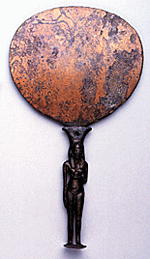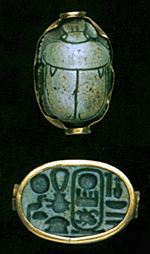|


Bronze mirror
(E10312), Dynasty 18 (1539-1292 B.C.).

Scarab seal
(E13055), made of steatite and gold, Mid-Dynasty 18-Dynasty 19 (1479-1190
B.C.).
|
|
Gallery
Tour
|
|
DAILY
LIFE
in
Ancient Egypt
|
The
artifacts preserved in the University of Pennsylvania's (UPM) Egyptian
collection provide significant information on the many facets of the daily
life of the ancient Egyptians. The material comes from actual town and
settlement excavations as well as from funerary
contexts where objects of daily life were often deposited for use in the
afterlife.
Mirrors
Mirrors were made from bronze and the reflecting surface would have
been highly polished to allow its owner to see his or her image reflected.
The handles of ancient Egyptian mirrors were often highly decorative
and may have had amuletic significance. Papyrus plants were common handle
motifs from the Middle Kingdom onward. Young, naked women appear on
handles from the New Kingdom, and are often shown holding offerings
that symbolize fertility
Jewelry
The ancient Egyptians are well known for their beautiful jewelry. Goldsmiths
and jewelers created spectacular necklaces, collars, bracelets, and
rings for wealty individuals using gold, silver, electrum (a natural
alloy of gold and silver), and semi-precious stones such as lapis lazuli,
carnelian, and turquoise. Attractive imitations of these more costly
materials were also produced out of faience, a man-made glazed quartzite
paste that could be molded into beads of amulets.
Models
Models were very popular in tombs of the Middle Kingdom and display
aspects of daily life in Ancient Egypt. These figures were placed in
the tomb as magical replacements for the real things for use by the
tomb owner in the afterlife and may have served a similar function to
the two dimensional scenes of everyday life carved and painted on tomb
walls. Models of butchering, granaries, and boats were common.
Wine Jars
The Ancient Egyptians were fond of wine
and beer and often included requests for both in their offering prayers
and menu lists found in tombs. Both wine
and beer were used in religious and other rituals as well as in the
everyday diet. The large wine jar to the left is from the tomb of a
woman named Minedjem and contained two different types of wine. The
hieroglyphic labels
identify the variety of wine. Pottery of this type, with blue-painted
floral decoration, is characteristic of the late 18th and early 19th
Dynasties.
|


